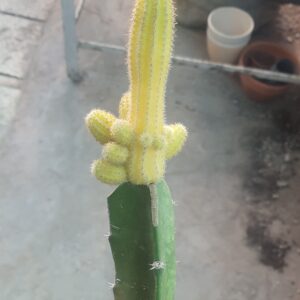The Fruit-Bearing Columnar Giant: Peruvian Apple Cactus” Cereus repandus
The Peruvian Apple Cactus, also known by its scientific name Cereus repandus (syn. Cereus peruvianus), is a beautiful columnar cactus native to South America, especially the regions of Peru, Brazil, and Argentina. It’s a useful and beautiful plant that can be used in cactus gardens, big pots, and landscapes because of its outstanding vertical growth, blue-green stems, and capacity to produce edible fruit.
The sculptural shape, drought tolerance, and architectural beauty of this species make it popular in contemporary landscaping. It’s a useful multipurpose cactus since, when it’s mature, it also gives farmers big, gorgeous blooms and tasty fruit.
Overview of Botany
Scientific Name: Cereus repandus (syn. Cereus peruvianus)
Common Names: Hedge Cactus, Giant Club Cactus, Peruvian Apple Cactus
Cactaceae is the family.
Indigenous Distribution: South America (Peru, Argentina, Brazil)
Tall, columnar cactus with ridged stems is its growth habit.
Size:
Wild: Up to 10 meters (30+ feet)
Usually 2–5 meters (6–15 feet) tall when grown.
9b–11 is the USDA Hardiness Zone.
Flowers and Fruits
Summer is the blooming season.
Flowers:
Big, white, and fragrant
Only blooming at night and having a short lifespan (normally only lasting one night).
attracts nighttime pollinators such bats and moths
Fruits (Peruvian Apples):
arise following flower pollination
Pink to red skin with white pulp, rounded to oval.
With tiny edible seeds, flesh is moderately sweet and resembles dragon fruit.
Older, well-established plants often produce fruit.
Requirements for Light
In the home:
Needs 6+ hours of direct, strong sunshine every day
Position close to a window facing west or south
May gain from extra grow lights
Outside:
likes direct sunlight
Although it can withstand some partial shade, it grows best in sunny, exposed locations.
A lot of sunlight is essential for strong development and spine growth.
Humidity and Temperature
Temperature:
Thrives in temperatures between 20 and 35°C (68 and 95°F)
If the soil is dry, it may withstand infrequent drops to -1°C (30°F).
Not resistant to frost; shield from extended exposure to low temperatures
Humidity:
Likes low humidity
To avoid fungal problems, a good airflow is necessary.
Ideal for arid, dry climates or dry indoor environments.
💧 Watering Schedule
The Growing Season (Spring to Fall):
If the soil is completely dry, water it well.
depending on the circumstances, usually every 2–3 weeks outside and every 10–14 days inside.
To prevent root rot, avoid water accumulation at the base.
Winter Dormancy:
Just once a month, use water sparingly.
Allow the soil to remain largely dry throughout the winter.
Overwatering is a frequent danger, notably inside.
Requirements for Soil
Type:
Needs soil that is sandy and drains well.
Suggested combination:
half cactus, half succulent soil
25% coarse sand
25% pumice or perlite
The pH ranges from somewhat acidic to neutral (6.0–7.0).
Its natural environment’s rough, sandy soils are replicated here.
Fertilizing
The Growing Season:
Every month, use a balanced cactus fertilizer (10-10-10 or 5-10-10) to fertilize.
Encourages development and the possibility of fruit production
Winter:
No fertilization is necessary throughout the dormant period.
✂️ Upkeep and Pruning
Pruning:
Except for:
Maintain elevation
Cut off any stems that are sick or injured.
Make an aesthetic shape
Insects:
Often pest-resistant, but sometimes susceptible to:
Mealybugs
Insects that scale
Spider mites
Use neem oil or insecticidal soap as treatment.
Propagation
By cuttings:
The most popular approach
Allow the cut stem to callus for one to two weeks after making a healthy cut.
Water lightly after planting in well-draining soil until roots develop.
The best time is from spring to the start of summer.
By Seeds:
In a cactus mixture, the fruit’s seeds can be planted.
Warmth and patience are necessary for germination.
Compared to seeds, cuttings grow faster and are more dependable.
Common Problems
Root Rot: brought on by excessive watering or inadequate drainage
Sunburn: From exposure to strong sunlight all of a sudden
Pest Infestations: Infrequent but likely in bad circumstances
To avoid these problems, make sure there is enough sunlight, regular watering intervals, and good drainage.
Use as decoration and for practical purposes
Outside Landscaping: Serving as the focal point of a desert garden or xeriscape
Large Pots for Indoors: Gorgeous architectural plant
Fruit Production: Cultivates fruit that may be eaten in warm, sunny environments.
Its towering shape and capacity to produce fruit and flowers make it a favorite among gardeners and cactus aficionados.
✅ Conclusion
The Peruvian Apple Cactus is a low-maintenance, visually striking plant that rewards the patient grower with edible fruits as well as beautiful flowers and impressive development. It can flourish both indoors and outdoors, standing tall as a real cactus jewel, provided it receives adequate care, including plenty of sunlight, well-drained soil, and little watering.”

Peruvian apple cactus
Original price was: ₨1,499.00.₨999.00Current price is: ₨999.00.
“The Peruvian apple cactus, also known as Cereus peruvianus, is a tall, columnar cactus that is indigenous to South America. It is known for its ribbed, bluish-green stems, which have clusters of tiny spines along the ridges. Due to its potential height of many meters, the cactus stands out as an architectural plant.
Following the blooming of its large, fragrant, white blooms at night, this cactus produces edible fruits known as “”Peruvian apples”” or “”Pitaya,”” which are sweet with a slight tang. It prefers well-drained soil in direct sunlight and doesn’t require frequent watering after it’s established since it can withstand drought.
The **Peruvian Apple Cactus** is prized for its quick growth, appealing shape, and edible fruit, making it a fantastic option for big gardens, xeriscapes, or as a stunning potted specimen.”




Reviews
There are no reviews yet.